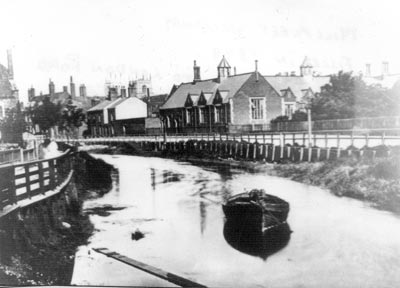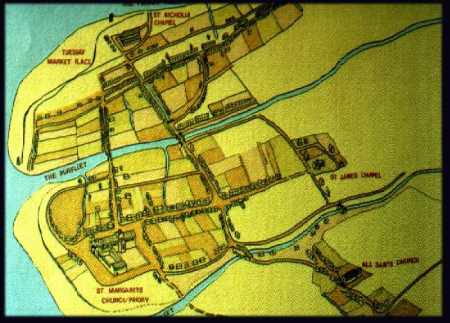The first reference to a mill in this area mentions Sewoldsfled in 1101. It is unclear whether the later name Sunolf's Fleet c.1250, is a corruption of this or associated with the family of Robert fitz Sunolf, first mayor of Lynn. At this time the fleet was known as Mayorsfleet, while the bridge crossing it was called both Mayor's bridge and Sunolf's bridge. Later it was known as Swaggesfleet, after the mill owner and eventally as Millfleet. |
The first mill known on this site was Scales Mill, built by the lord of South Lynn, Lord Scales. It was later known as Swagges Mill but was derelict by the late 1300s. |
Millfleet was strongly tidal and had a relatively small flow of its own water, which meant that the mill was constantly running out of water. |
 |
Millfleet c.1875 |
Inquest held before the coroners of Lynn on 22 May 1296 into the death of Roger fitz Claricia miller [...] the jurors say that around the middle of the day on 19 May, Roger arose from his midday nap and went down to the water next to the lesser water-wheel of the mill in Lynn called Swargermelne [Millfleet] to wash his hands, when he tripped over himself and fell onto the beam called briggetre. Of which [injury] he languished from that hour until vespers on the following Monday. |
John Wynch miller for a mill leased him with 2 cottages and gardens opposite St. James chapel. (Of the rent, 20s. belongs to the Bishop and 20s. to the Prior of Lynn.) [This would have been the grain mill, whose site was acquired by the town from the Bishop, for an annual farm of 20s., in August 1392. The king’s ratification of this agreement, the following month, indicated the site (to be selected by the burgesses) was to be on Millfleet where Swagges Mill had once stood, or between that site and the Gannock gate (one of the lesser gates on the east boundary of the town). The burgesses were admonished: not to damage the fleet when excavating for the new mill; not to block the fleet’s course, which ran eastwards to the Bishop’s demesne at Mintling; not to allow the mill to back up water so that floods resulted, as had happened with Swagges Mill; and to ensure the causeway (raised road) on the north side of the fleet was maintained. Robert Perch miller had leased the mill for three years in July 1424, but he later complained that bakers and others were not bringing corn to him to have it ground; in November the borough released him from the arrangement and leased the mill to Wynch for seven years. Wynch probably encountered the same problem for, in March 1426 the borough issued an order for all bakers to grind their grain at the town mill; but the problem persisted and, shortly after the end of Wynch’s term, the borough passed an ordinance obliging townsmen to take their grain to the town mill. The cottages and gardens had been associated with the farm of the mill since at least 1399.] |
